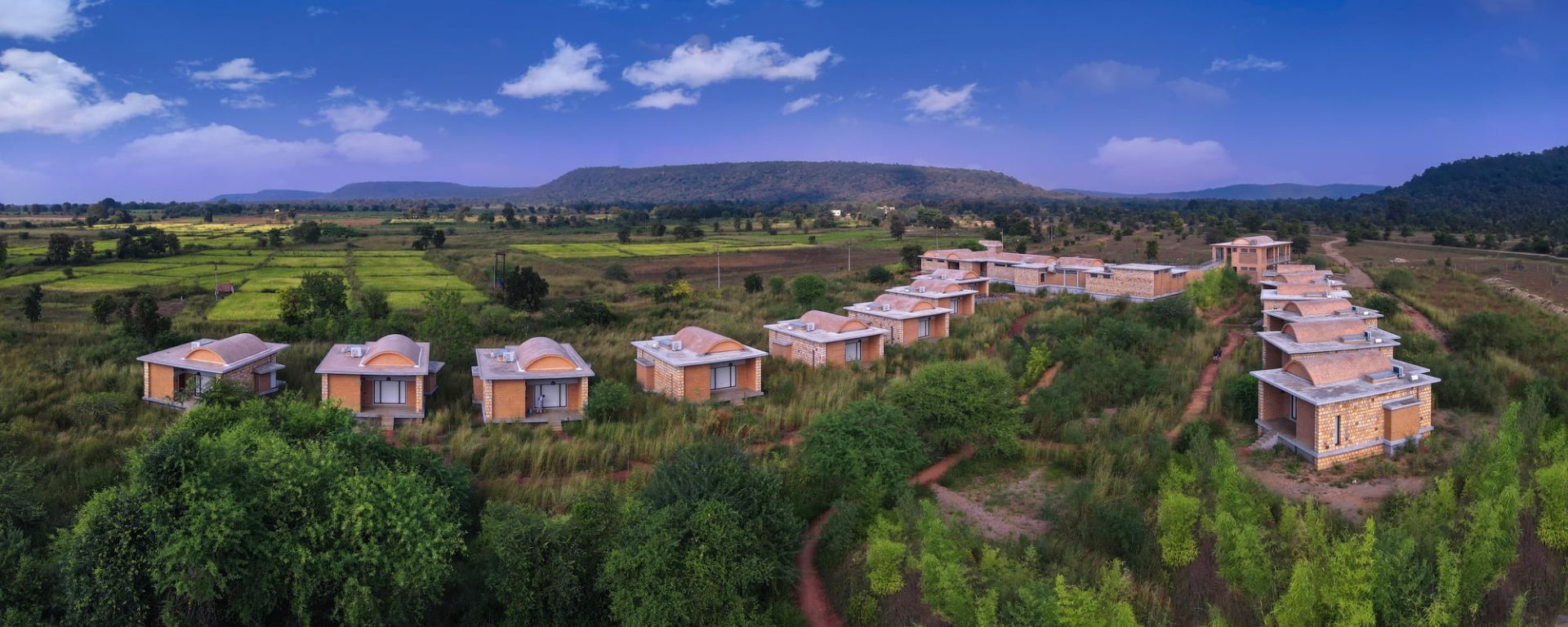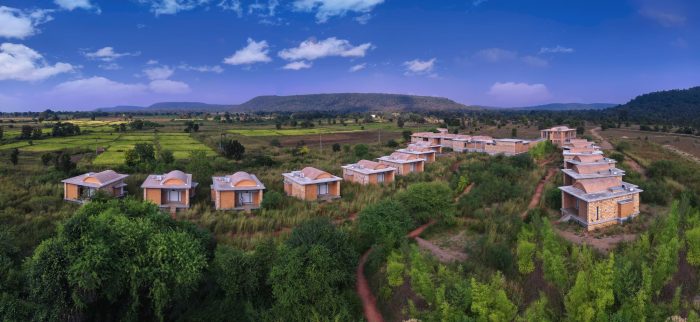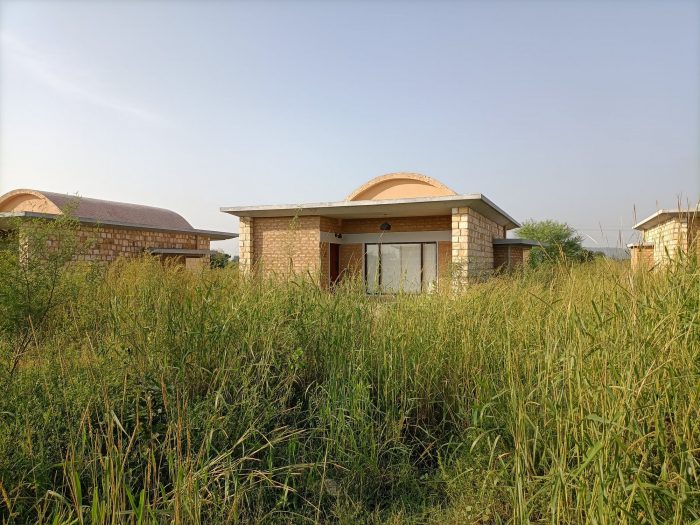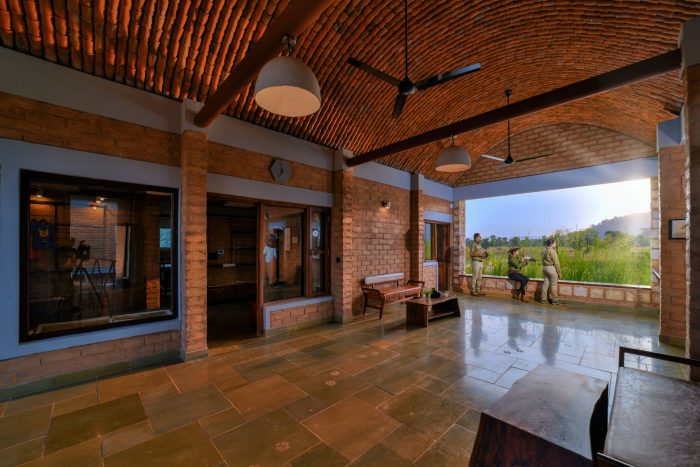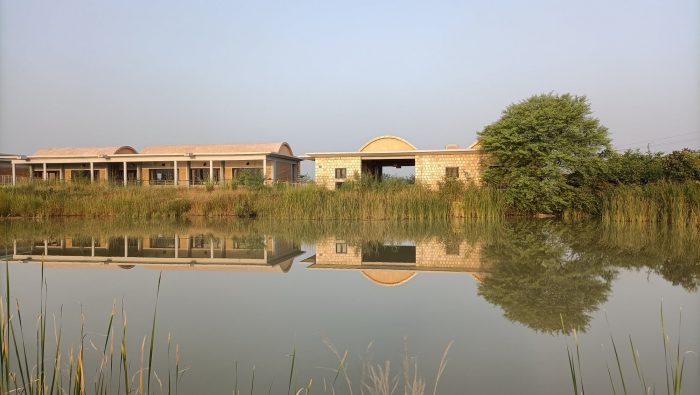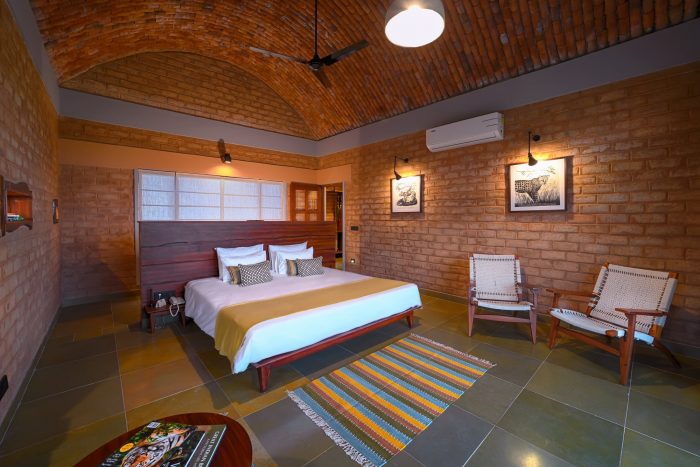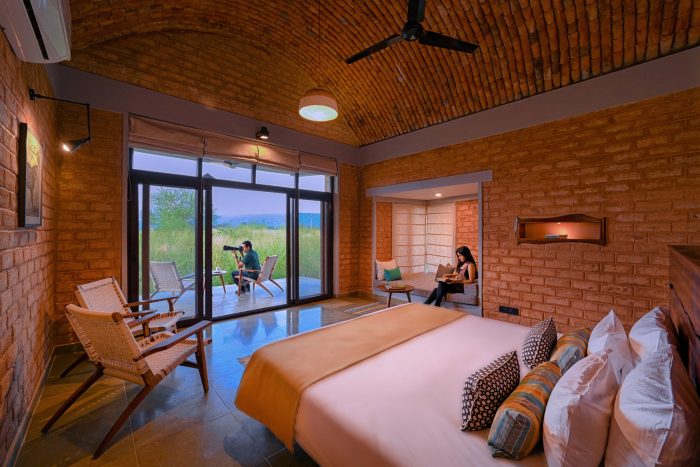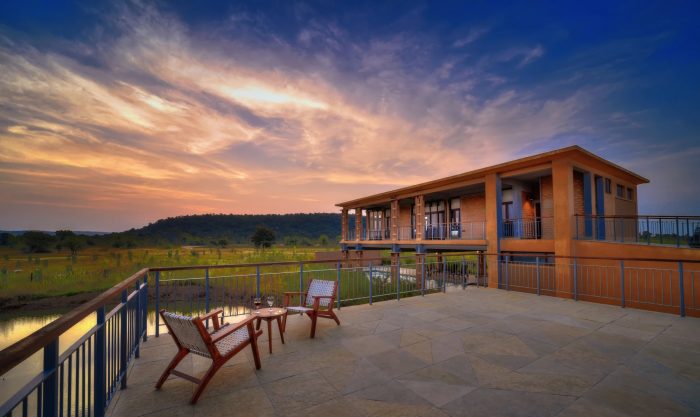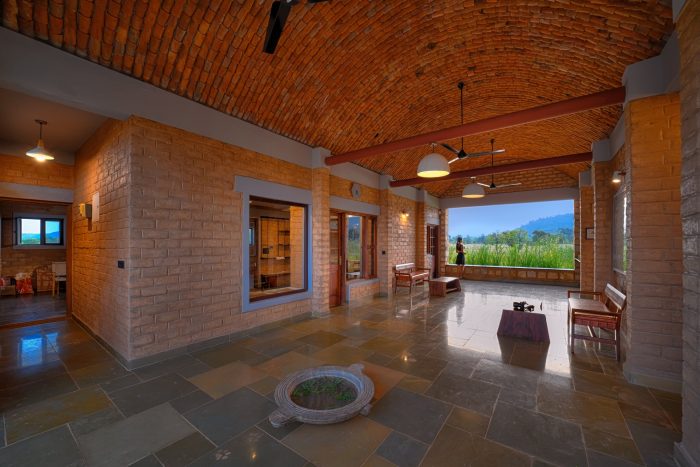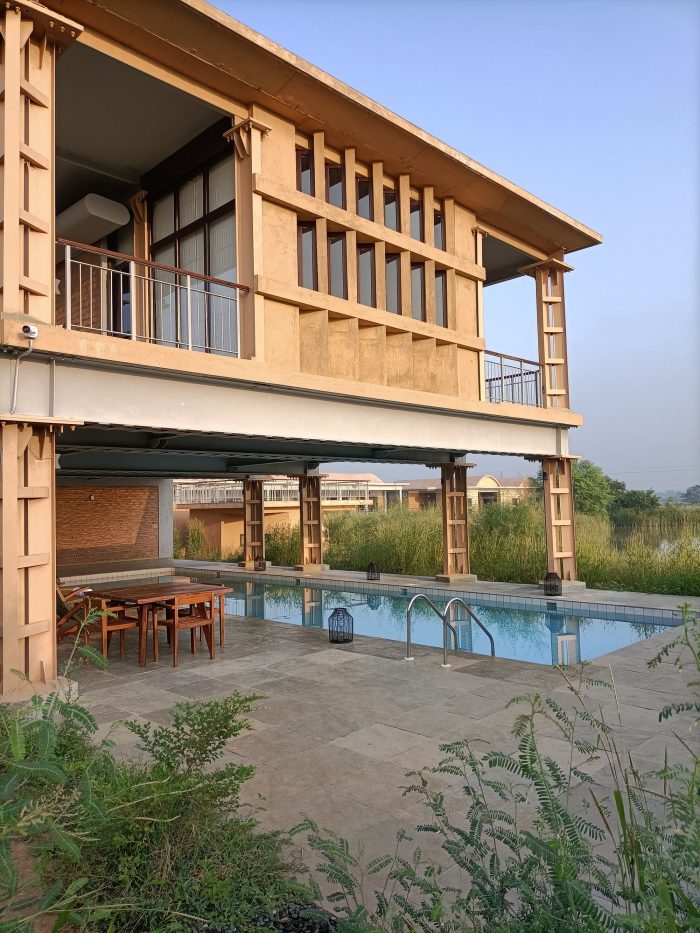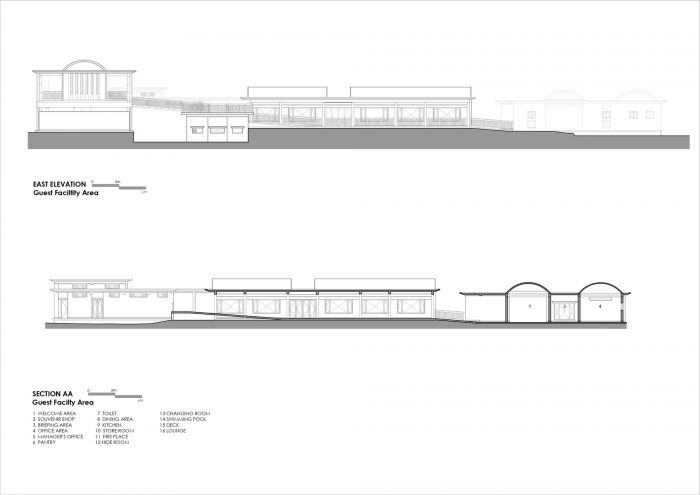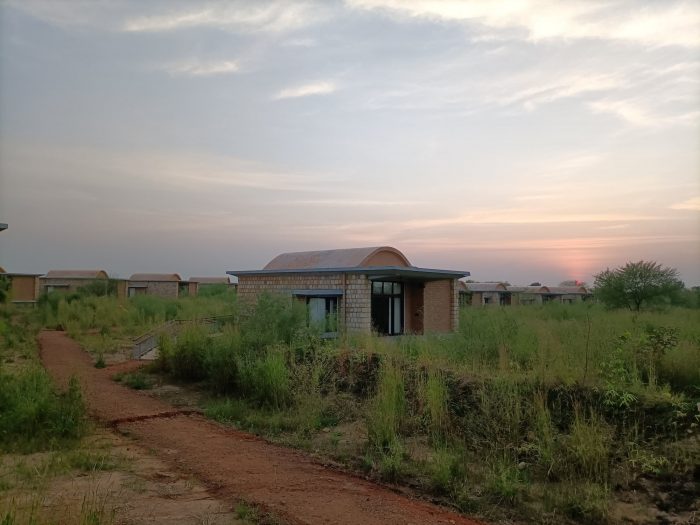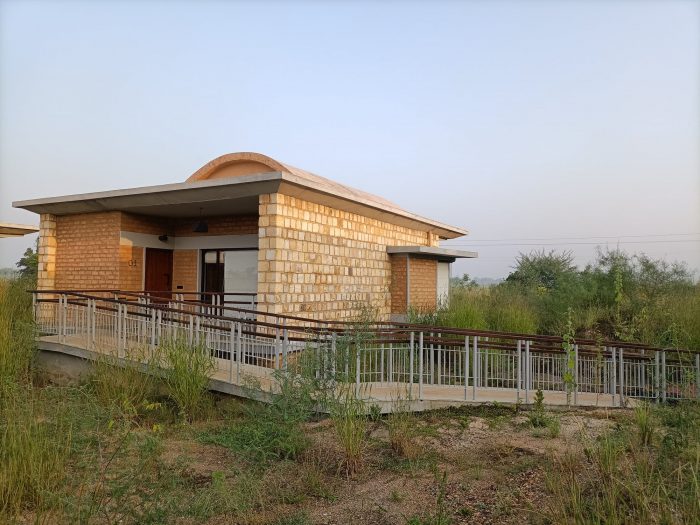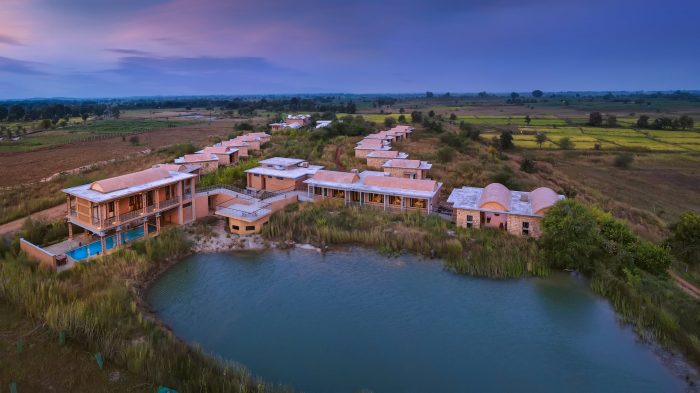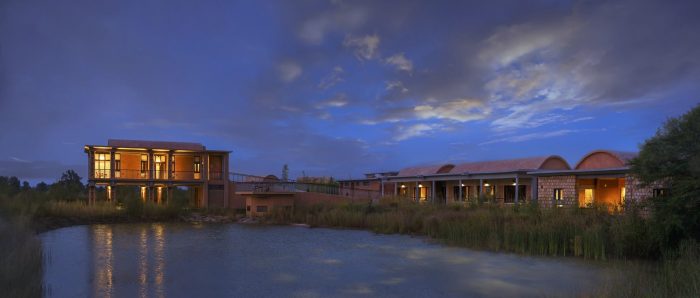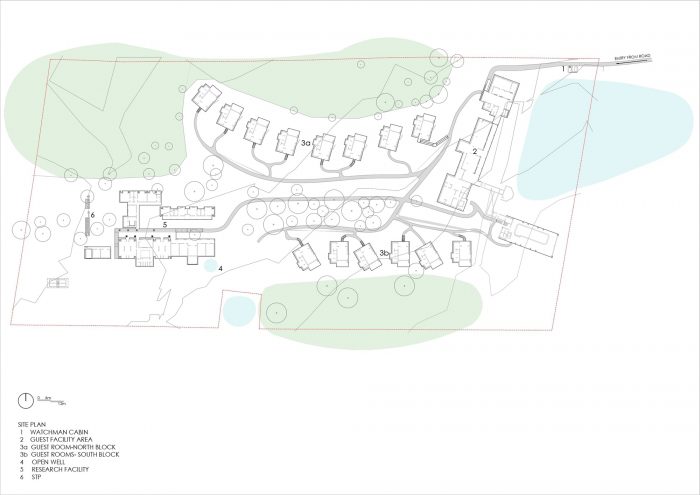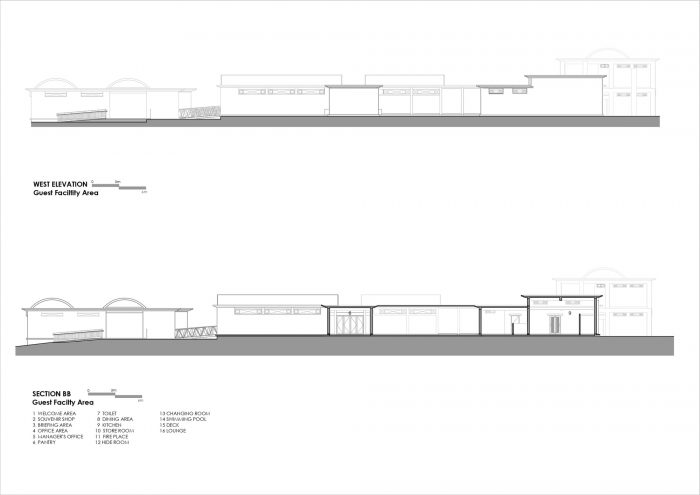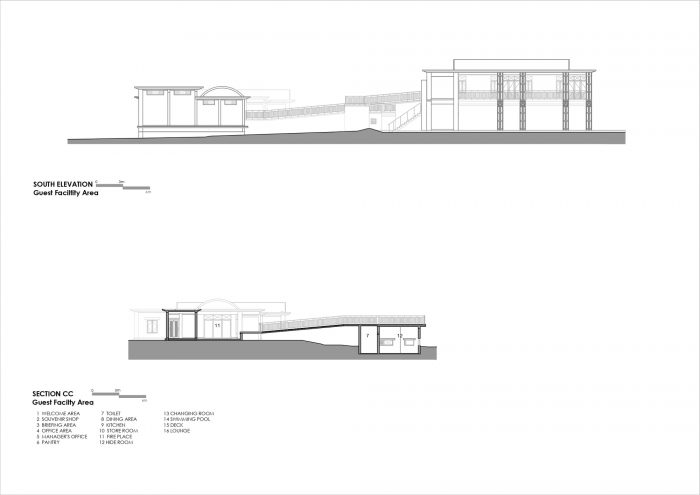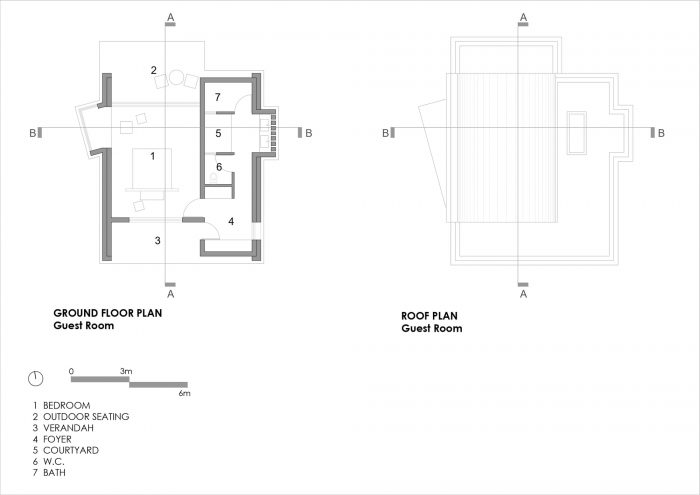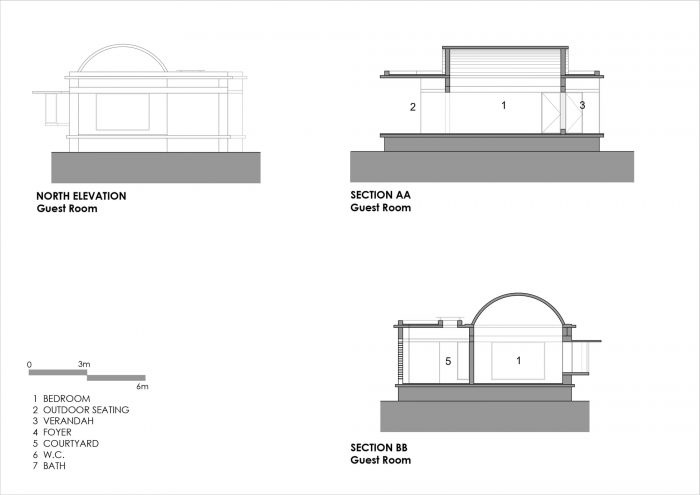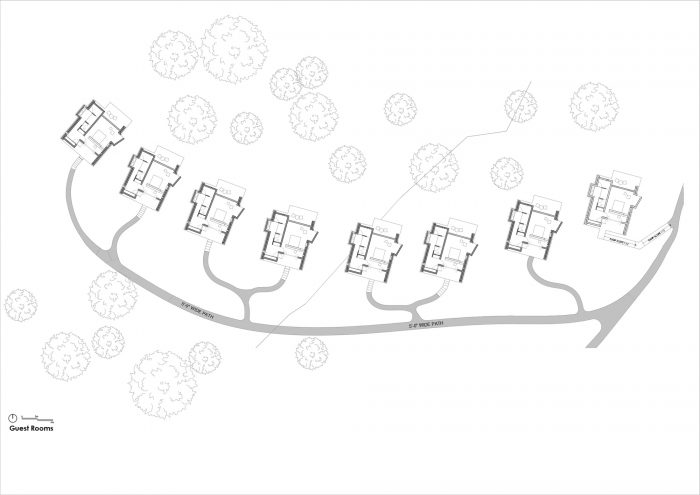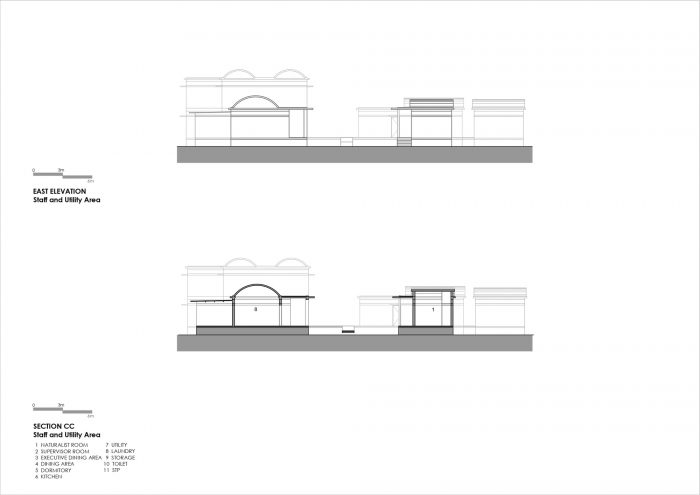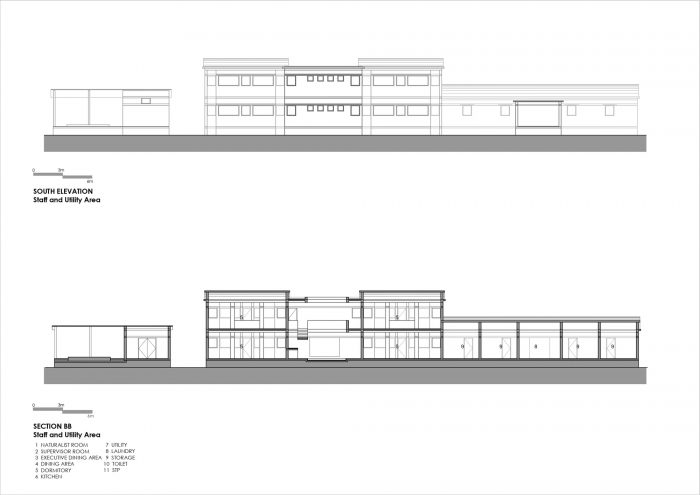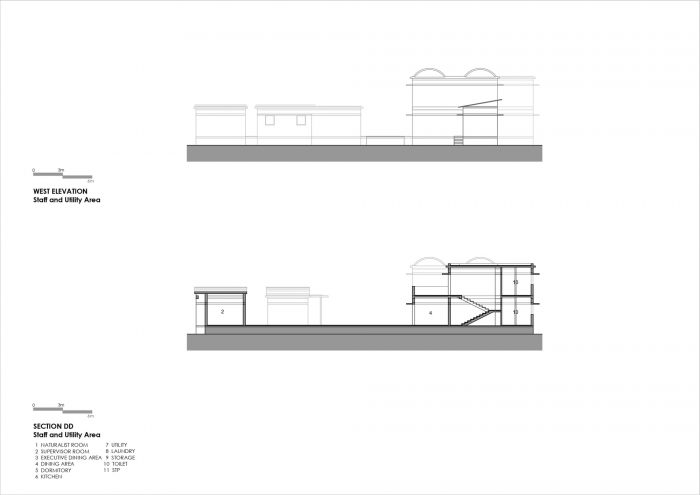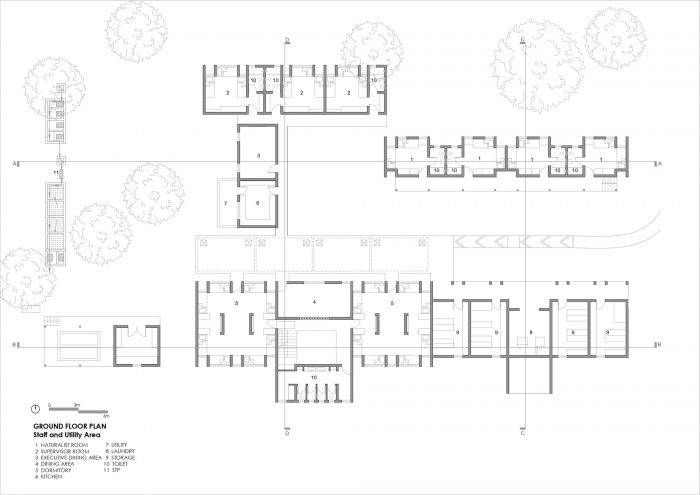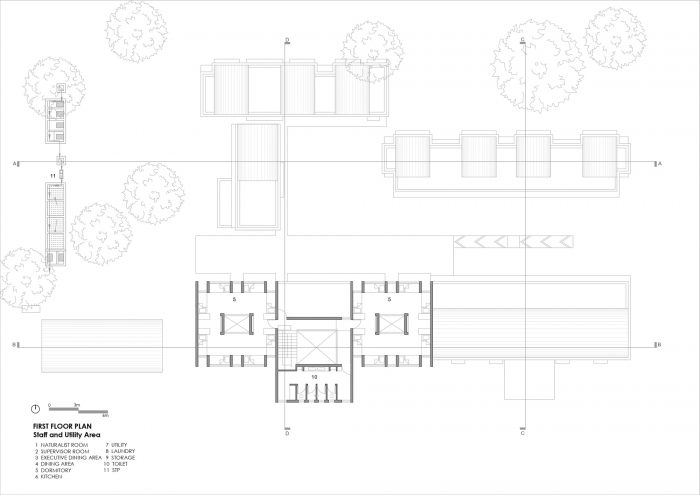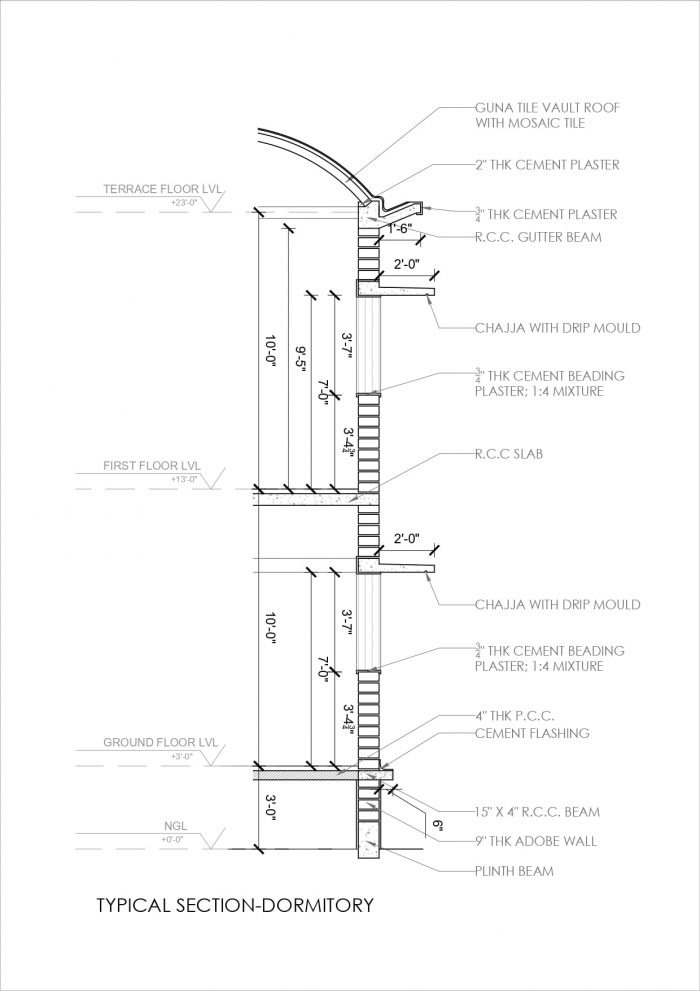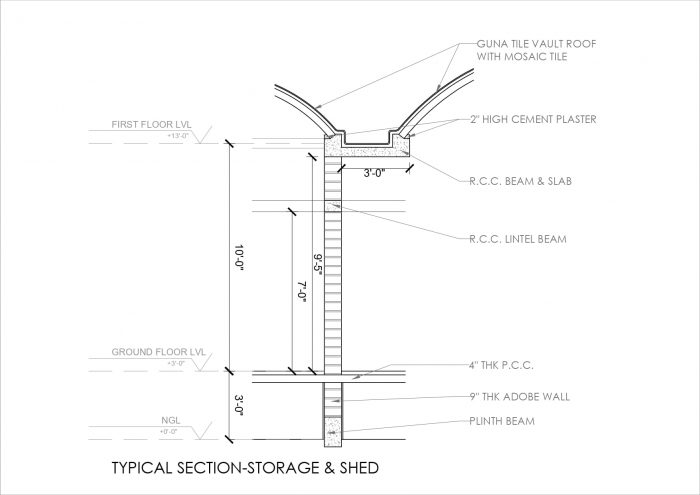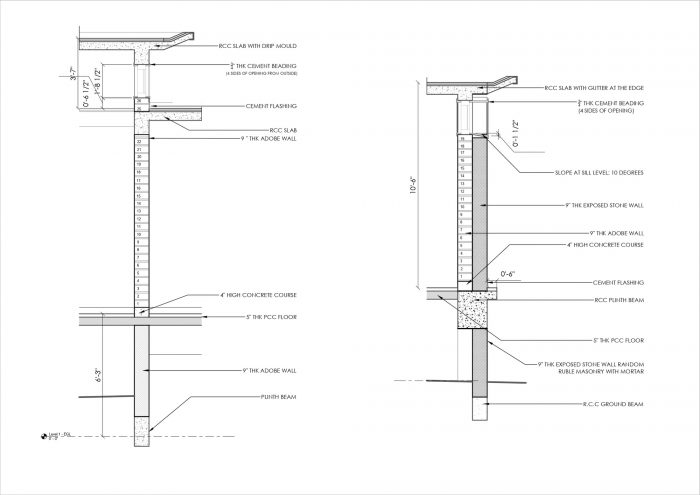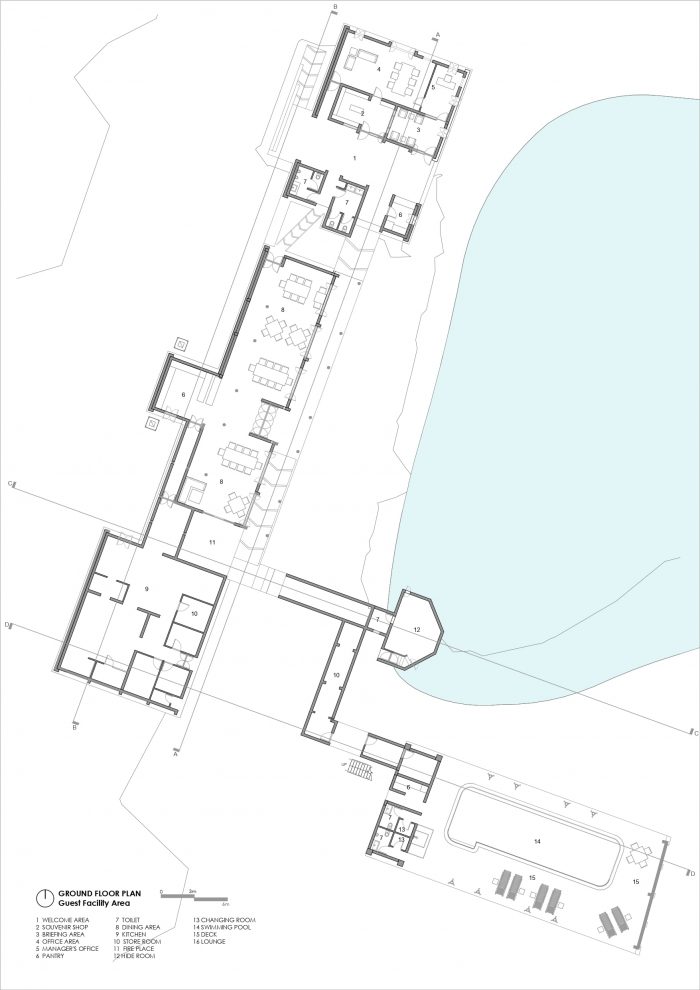Waghoba ecolodge是一个与印度马哈拉施特拉邦的Tadoba野生动物保护区的森林缓冲区相邻的度假村。该物业的目标客户群是野生动物爱好者和保护主义者。方案要求建立一个以负责任的旅游为核心的16间小屋的度假村。开发商试图将以前的耕地恢复到落叶林的原始状态,作为其生态意图的一部分。这需要对景观进行干预,以提高生物多样性。通过观察周围的土地,并通过生物多样性调查,确定了当地的植物群和动物群。
Waghoba ecolodge is a resort contiguous to the forest buffer of Tadoba wildlife sanctuary in the state of Maharashtra India. The target clientele for the property is wildlife enthusiasts and conservationists. The brief required a 16-cottage resort with responsible tourism at its core. The developers sought to restore the previously cultivated land to its original state of being a deciduous forest as part of their ecological intentions. This required interventions in the landscape to enhance biodiversity. By observing the land around and through a biodiversity survey local flora and fauna were identified.
为了使生物多样性蓬勃发展,在这个地区的半干旱气候中加入一个水体是非常重要的。在夏天,这里的温度上升到48摄氏度。通过确定现有的堤坝和清淤渠道,在度假村的入口处建立了一个湖。这个湖储存了雨水和处理过的废水。额外的本土植物物种的造林为动物群接近湖泊提供了一条绿色走廊。这个湖现在是众多鸟类和动物的家园。在设计中,为爱好者和专业的野生动物摄影师引入了一个观景台,以观察动物群在其自己的栖息地。
For biodiversity to flourish it was essential to incorporate a water body in the semi-arid climate of this region. In the summer temperature here rises to 48-degree C. By identifying the existing bund and desilting the channels a lake was made at the entrance of the resort. This lake stored the rainwater and treated wastewater. Additional afforestation with indigenous plant species provides a green corridor for the fauna to approach the lake. This lake now is home to a plethora of birds and animals. A lookout hide has been introduced in the design for enthusiasts and professional wildlife photographers to watch the fauna in its own habitat.
托达巴的景观在一年中的大部分时间里都有金色到深褐色的各种色调,在季风期间则是绿色。在建筑干预的材料调色板上,已经捕捉到了金色到棕色的色调。材料调色板是当地砂岩和稳定的土坯的组合,在现场使用当地土壤制作。湖泊成为项目的中心。主体建筑和它的欢迎区在这个湖边。在这里,当旅行者准备出发去森林旅游时,他们也能享受到初升的太阳。沿着用餐区和休息室的腰带可以看到湖泊、森林和傍晚的天空。在这个高处的休息室下面是一个遮阳的游泳池,其甲板可以俯瞰湖面。游泳池的天花板由锅盖填充,创造了动态反射,同时从生态学角度减少了材料的消耗。
The landscape of Todaba’s has a variety of shades of gold to dark brown for the most part of the year and green during the monsoons. Capturing of the gold to brown hue has been done in the material palette of the architectural interventions. The material palette is a combination of local sandstone and stabilized adobes made at the site using local soil. The lake becomes the loci of the project. The main building and its welcome area, edge this lake. Here the travelers also enjoy the rising sun when they are getting ready to leave for the forest tour. Belvederes along the dining area and the lounge enjoy views of the lake, forest, and the evening skies. Below this elevated lounge is a shaded swimming pool with its deck overlooking the lake. The ceiling of the pool which has a filler of pot lids creates dynamic reflection while ecologically reducing material consumption.
客人们被安置在沿东西轴线放置的别墅中,这些别墅位于庄园的核心位置。每间别墅的南北两面都有大的开口,并有深长的阳台遮挡。书桌和床都可以看到缓冲区,给人一种生活在森林里的体验。由于夏季是游猎的高峰期,建筑的设计是通过使用被动策略来减少冷却负荷。东面和西面的复合石墙和土坯墙减少了热量摄入。厕所和更衣区为房间挡住了西方的阳光。在盥洗盆附近有一个带有热反射玻璃的小天窗,为厕所区域带来了充足的光线。由锥形陶瓦制成的拱形屋顶,中间有空气间隙,顶部有陶瓷马赛克,使室内空间免受来自屋顶的偶然热量。
The guests are accommodated in the cottages placed along the east-west axis at the core of the property. Each cottage has large openings in the north and south shaded by deep verandahs. Both the study desk and bed view the buffer areas giving an experience of living in the forest. As the peak season for safaris is summer the buildings are designed to reduce the cooling loads by using passive strategies. Composite stone and adobe walls on the east and west side reduce the heat gain. Toilet and the changing area shield the room from the western sun. A small skylit roof with heat reflective glass near the vanity wash basins brings in an ample amount of light inside the toilet area. A vaulted roof made of conical pottery tiles with air gaps between and ceramic mosaic on top insulates the interior spaces from the incidental heat from the rooftop.
客人区的内部装修继续采用相同的色调,即从浅到深的棕色和赤土红色。带有金棕色Kota(石灰石)的地板与土坯墙很好地融合在一起。赤土红色的屋顶瓦片形成了一种对比,使拱形天花板更加突出。带有暖黄色灯光的铁丝网照明设备营造了一种非常舒适的氛围。位于西面的员工住房经过精心布置,为居住者在休息时提供安静的空间和隐私。高级员工宿舍采用了与客房类似的设计语言,采用土坯墙和赤土拱顶。初级员工宿舍的设计是在每一个床位附近提供窗户。承重翅片墙作为各个床位之间的隔断,为用户提供了一定程度的隐私。员工宿舍屋顶的水被收集并储存在10万升的储水箱中。
The interior finishes of the guest areas continue the same color palette of light to dark brown and terracotta reds. The floor with golden brown Kota (limestone) blends well with the adobe walls. The terracotta red roof tiles create a contrast and make the vaulted ceiling stand out even more. The ferrocement lighting fixtures with warm yellow light set a very cozy mood. Staff housing on the west is carefully located to provide quiet space and privacy to its occupants while they are resting during breaks. The senior staff housing uses a similar design language to the guest rooms with adobe walls and terracotta vaulted ceilings. Junior staff dormitories are designed to offer windows near every single bed space. Load-bearing fin walls act as a partition between individual beds offering some level of privacy to its users. Water from the staff housing roof is harvested and stored in the 0.1million liter of the water storage tank.
该物业的所有污水都使用国家环境工程研究所NEERI开发的植物水处理系统PHYTORID进行处理,随后用于种植有机蔬菜和该物业的森林。使用赤土作为RCC板的填充物或住宅空间的屋顶,增加了循环经济的概念。这些都是在村里和当地生产的,并使用湖泊中的清淤土壤。
All the sewage water from the property is treated using a plant-based water treatment system PHYTORID developed by National Environmental Engineering Institute NEERI and is subsequently used for growing the organic vegetables and the forest on the property. The use of terracotta either as filler in the RCC slabs or roofs for the residential spaces adds to the concept of the circular economy. These are produced in the village and local areas and use the desilted soil from the lakes.
由于大多数建筑,甚至是农村地区的建筑都采用RCC结构,这些技能正在消亡。随着当地人的迁移和农业活动的减少,湖泊的清淤工作停止了。不清淤会导致含水层补给的减少。我们有意识地使用赤土,使该设施成为虚拟循环的一部分。我们希望该设施能展示出生态建筑与生态系统的同步性。拱形屋顶是与瓦尔达村落科学中心(CSV)合作完成的。这是一个根据甘地原则和价值观工作的组织。这个项目对我们来说是一个生态、社会和休闲的愉快合作。
Since most buildings even in the rural area are adopting RCC construction these skills are dying out. As locals migrate and agricultural activity reduces the desilting of lakes stops. The non-desilting leads to a drop in aquifer recharge. We used terracotta consciously to make the facility part of a virtual cycle. We want the facility to showcase that ecological architecture is in sync with the ecosystem. The vaulted roofs were done in collaboration with the Centre for Science for Villages (CSV) Wardha. This is an organization that works on Gandhian principles and values. The project for us is a happy collaboration of ecology, social, and leisure.
Architects: Biome Environmental Solutions
Area : 3085 m²
Year : 2021
Photographs :Lalit Rajoria
Manufacturers : Hindware, Adish Aluminium, Bathline, The Purple Turtles
Design Team : Chitra Vishwanath, Anurag Tamankar, Maitri Shah
Client : Pugdundee Safaris
Structural Consultant : Satish Raipure
Phe Consultant : HMNagesh
Civil Works : Vikesh Agarwal
Swimming Pool : Nandadeep Pools
City : Bengaluru
Country : India

